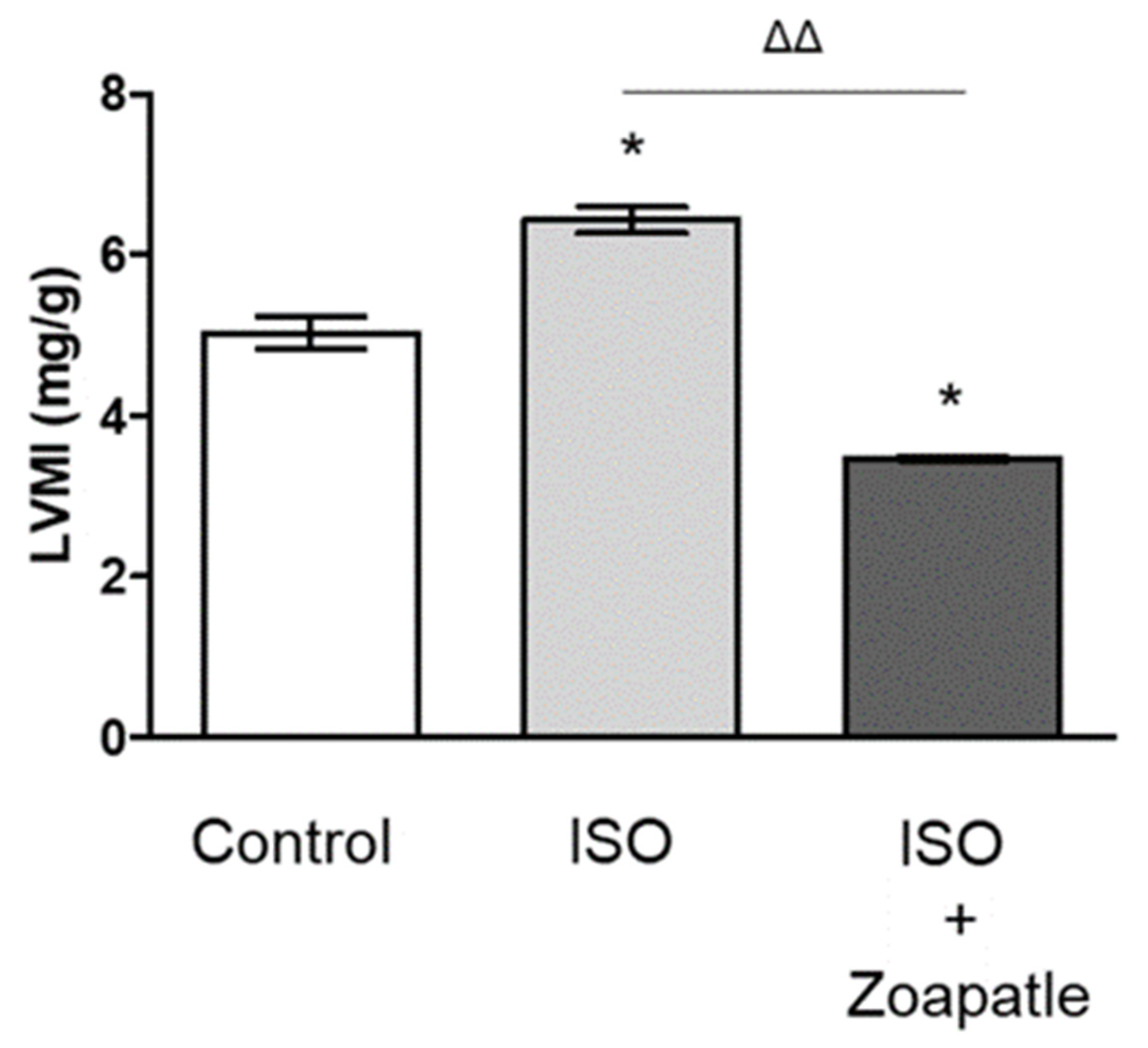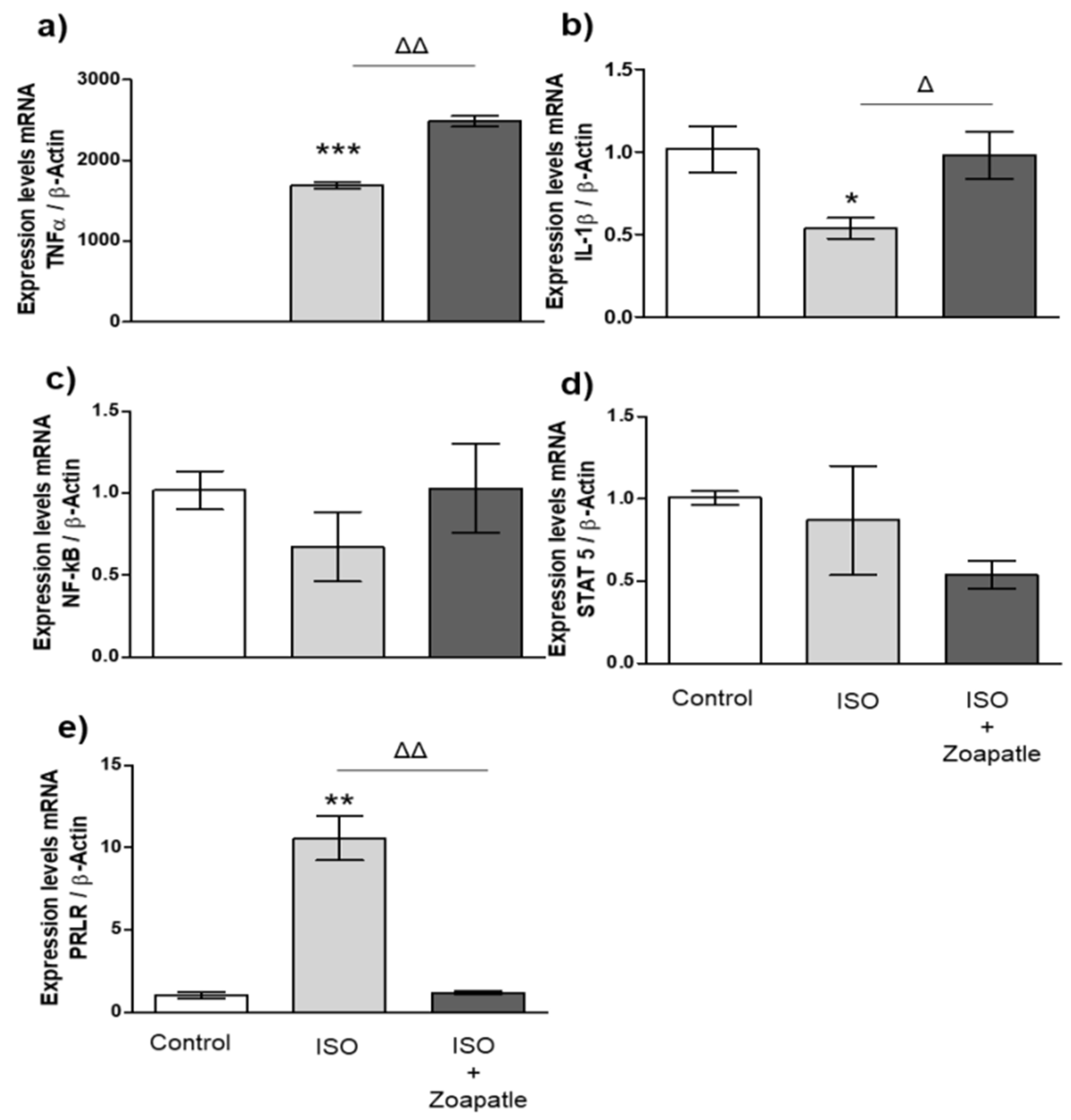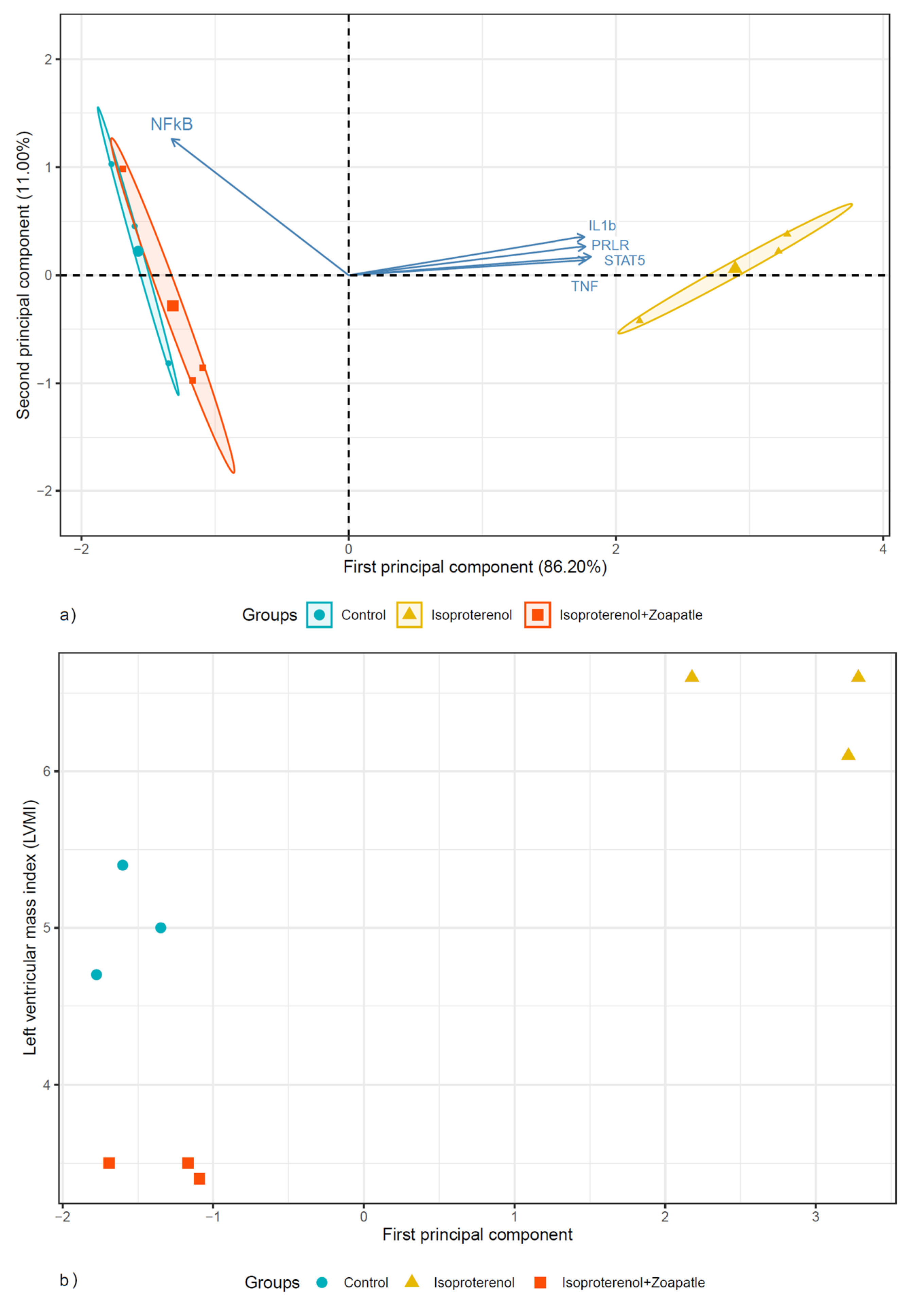Effect of Zoapatle (Montanoa tomentosa) on Inflammatory Markers in a Murine Model of Ventricular Hypertrophy
Abstract
1. Introduction
2. Materials and Methods
2.1. Ethical Approval
2.2. Experimental Design
2.3. Total RNA Extraction and cDNA Synthesis
2.4. RT-qPCR
2.5. Principal Component Analysis (PCA) of Genes in Hypertrophy
2.6. Statistical Analysis
3. Results
3.1. Isoproterenol-Induced Cardiac Hypertrophy
3.2. Gene Expression in the Left Ventricle
3.3. Gene Expression in the Brain
3.4. Gene Expression in the Renal Cortex
3.5. Principal Component Analysis
4. Discussion
5. Conclusions
Author Contributions
Funding
Institutional Review Board Statement
Informed Consent Statement
Data Availability Statement
Conflicts of Interest
References
- Villa-Ruano, N.; Betancourt-Jiménez, M.G.; Lozoya-Gloria, E. Biosynthesis of uterotonic diterpenes from Montanoa tomentosa (zoapatle). J. Plant Physiol. 2009, 166, 1961–1967. [Google Scholar] [CrossRef] [PubMed]
- Gallegos, A.J. The zoapatle I—A traditional remedy from Mexico emerges to modern times. Contraception 1983, 27, 211–225. [Google Scholar] [CrossRef] [PubMed]
- Carro-Juárez, M.; Lobatón, I.; Benítez, O.; Espíritu, A. Pro-ejaculatory effect of the aqueous crude extract of cihuapatli (Montanoa tomentosa) in spinal male rats. J. Ethnopharmacol. 2006, 106, 111–116. [Google Scholar] [CrossRef] [PubMed]
- Southam, L.; Pedrón, N.; Ponce-Monter, H.; Girón, H.; Estrada, A.; Lozoya, X.; Enríquez, R.G.; Bejar, E.; Gallegos, A.J. The zoapatle IV—Toxicological and clinical studies. Contraception 1983, 27, 255–265. [Google Scholar] [CrossRef] [PubMed]
- Plovanich, A.E.; Panero, J.L. A phylogeny of the ITS and ETS for Montanoa (Asteraceae: Heliantheae). Mol. Phylogenetics Evol. 2004, 31, 815–821. [Google Scholar] [CrossRef] [PubMed]
- Pedrón, N.; Estrada, A.V.; Ponce-Monter, H.; Valencia, A.; Guzmán, A.; Gallegos, A.J. The zoapatle. VII. Antiimplantation effect in the rat of zoapatle aqueous crude extract (ZACE) from Montanoa tomentosa and Montanoa frutescens. Contraception 1985, 31, 499–507. [Google Scholar] [CrossRef]
- Landgren, B.M.; Aedo, A.R.; Hagenfeldt, K.; Diczfalusy, E. Clinical effects of orally administered extracts of Montanoa tomentosa in early human pregnancy. Am. J. Obstet. Gynecol. 1997, 135, 480–484. [Google Scholar] [CrossRef]
- Lozoya, X.; Enríquez, R.G.; Bejar, E.; Estrada, A.V.; Girón, H.; Ponce-Monter, H.; Gallegos, A.J. The zoapatle V—The effect of kauradienoic acid upon uterine contractility. Contraception 1983, 27, 267–279. [Google Scholar] [CrossRef]
- Carro-Juárez, M.; Cervantes, E.; Cervantes-Méndez, M.; Rodríguez-Manzo, G. Aphrodisiac properties of Montanoa tomentosa aqueous crude extract in male rats. Pharmacol. Biochem. Behav. 2004, 78, 129–134. [Google Scholar] [CrossRef]
- Ponce-Monter, H.; Girón, H.; Lozoya, X.; Enríquez, R.G.; Bejar, E.; Estrada, A.V.; Gallegos, A.J. The zoapatle III—Biological and uterotonic properties of aqueous plant extract. Contraception 1983, 27, 239–253. [Google Scholar] [CrossRef]
- Estrada-Camarena, E.; Sollozo-Dupont, I.; Islas-Preciado, D.; González-Trujano, M.E.; Carro-Juárez, M.; López-Rubalcava, C. Anxiolytic- and anxiogenic-like effects of Montanoa tomentosa (Asteraceae): Dependence on the endocrine condition. J. Ethnopharmacol. 2019, 241, 112006. [Google Scholar] [CrossRef] [PubMed]
- Sollozo-Dupont, I.; Estrada-Camarena, E.; Carro-Juárez, M.; López-Rubalcava, C. GABAA/benzodiazepine receptor complex mediates the anxiolytic-like effect of Montanoa tomentosa. J. Ethnopharmacol. 2015, 162, 278–286. [Google Scholar] [CrossRef] [PubMed]
- Omar, E.-M.; Francisco, R.-L.J.; Mario, C.; Miguel, C.-J.; Francisco, G.-O.; Margarita, S.-V.; Abraham, P.-O.; de Jesús, R.-H.M. Acute effect of an infusion of Montanoa tomentosa on despair-like behavior and activation of oxytocin hypothalamic cells in Wistar rats. J. Tradit. Complement. Med. 2020, 10, 45–51. [Google Scholar]
- Montoya-Cabrera, M.A.; Simental-Toba, A.; Sánchez-Rodríguez, S.; Escalante-Galindo, P.; Aguilar-Conteras, A. Cardiorespiratory depression in 8 newborn infants whose mothers took “yucuyahui” (Zoapatle-Montanoa tomentosa) during labor. Gac. Med. Mex. 1998, 134, 611–615. [Google Scholar] [PubMed]
- Venturella, F.; Mortillaro, F.; Cancellieri, G.; Giammanco, M.; Mistretta, I.; Liga, A.V. Montanoa tomentosa. A review of the new scientific evidence on pharmacological properties. J. Biol. Res.-Boll. Soc. Ital. Biol. Sper. 2022, 95. [Google Scholar] [CrossRef]
- Valencia, A.; Wens, A.; Ponce-Monter, H.; Pedrón, N.; Gallegos, A.J.; Quijano, L.; Calderón, J.; Gómez, F.; Ríos, T. Zoapatle. XII. In vitro effect of kaurenoic acid isolated from Montanoa frutescens and two derivatives upon human spermatozoa. J. Ethnopharmacol. 1986, 18, 89–94. [Google Scholar] [CrossRef] [PubMed]
- Braca, A.; Cioffi, G.; Morelli, I.; Venturella, F.; Pizza, C.; De Tommasi, N. Two new sesquiterpene lactones from Montanoa tomentosa ssp. microcephala. Planta Med. 2001, 67, 774–776. [Google Scholar] [CrossRef] [PubMed]
- Topcu, G.; Cordell, G.A.; Farnsworth, N.R.; Fong, H.H. Studies on zoapatle. VIII: Novel cytotoxic sesquiterpene lactones from Montanoa tomentosa ssp. microcephala. J. Pharm. Sci. 1988, 77, 553–556. [Google Scholar] [CrossRef]
- Müller, S.; Murillo, R.; Castro, V.; Brecht, V.; Merfort, I. Sesquiterpene lactones from Montanoa hibiscifolia that inhibit the transcription factor NF-kappa B. J. Nat. Prod. 2004, 67, 622–630. [Google Scholar] [CrossRef] [PubMed]
- Villa-Ruano, N.; Lozoya-Gloria, E. Anti-fertility and other biological activities of zoapatle (Montanoa spp.) with biotechnological application. Bol. Latinoam. Caribe Plantas Med. Aromat. 2014, 13, 415–436. [Google Scholar]
- Akihisa, T.; Franzblau, S.G.; Ukiya, M.; Okuda, H.; Zhang, F.; Yasukawa, K.; Suzuki, T.; Kimura, Y. Antitubercular activity of triterpenoids from Asteraceae flowers. Biol. Pharm. Bull. 2005, 28, 158–160. [Google Scholar] [CrossRef] [PubMed]
- Enriquez, R.G.; Escobar, L.I.; Romero, M.L.; Chavez, M.A.; Lozoya, X. Determination of grandiflorenic acid in organic and aqueous extracts of Montanoa tomentosa (zoapatle) by reversed-phase high performance liquid chromatography. J. Chromatogr. A 1983, 258, 297–301. [Google Scholar] [CrossRef]
- Tirapelli, C.R.; Ambrosio, S.R.; Coutinho, S.T.; de Oliveira, D.C.; da Costa, F.B.; de Oliveira, A.M. Pharmacological comparison of the vasorelaxant action displayed by kaurenoic acid and pimaradienoic acid. J. Pharm. Pharmacol. 2005, 57, 997–1004. [Google Scholar] [CrossRef] [PubMed]
- Cavalcanti, B.C.; Costa-Lotufo, L.V.; Moraes, M.O.; Burbano, R.R.; Silveira, E.R.; Cunha, K.M.; Rao, V.S.; Moura, D.J.; Rosa, R.M.; Henriques, J.A.; et al. Genotoxicity evaluation of kaurenoic acid, a bioactive diterpenoid present in Copaiba oil. Food Chem. Toxicol. 2006, 44, 388–392. [Google Scholar] [CrossRef] [PubMed]
- Cotoras, M.; Folch, C.; Mendoza, L. Characterization of the antifungal activity on Botrytis cinerea of the natural diterpenoids kaurenoic acid and 3beta-hydroxy-kaurenoic acid. J. Agric. Food Chem. 2004, 52, 2821–2826. [Google Scholar] [CrossRef] [PubMed]
- Vieira, H.S.; Takahashi, J.A.; Pimenta, L.P.; Boaventura, M.A. Effects of kaurane diterpene derivatives on germination and growth of Lactuca sativa seedlings. Z. Naturforschung C J. Biosci. 2005, 60, 72–78. [Google Scholar] [CrossRef] [PubMed]
- Waller, D.P.; Martin, A.; Oshima, Y.; Fong, H.H. Studies on zoapatle. V. Correlation between in vitro uterine and in vivo pregnancy interruption effects in guinea pigs. Contraception 1987, 35, 147–153. [Google Scholar] [CrossRef]
- Perusquía, M.; Sánchez, E.; Ponce-Monter, H.; Estrada, A.V.; Pedrón, N.; Valencia, A.; Guzmán, A.; Gallegos, A.J. The Zoapatle XI. Effects elicited by Mmontanoatomentosa and Montanoa frutescens on rat uterine strips. Contraception 1985, 31, 543–551. [Google Scholar] [CrossRef]
- Campos-Nonato, I.; Hernández-Barrera, L.; Pedroza-Tobías, A.; Medina, C.; Barquera, S. Hipertensión arterial en adultos mexicanos: Prevalencia, diagnóstico y tipo de tratamiento. Ensanut MC 2016 [Hypertension in Mexican adults: Prevalence, diagnosis and type of treatment. Ensanut MC 2016]. Salud Pública Méx. 2018, 60, 233–243. [Google Scholar] [CrossRef]
- Nakamura, M.; Sadoshima, J. Mechanisms of physiological and pathological cardiac hypertrophy. Nat. Rev. Cardiol. 2018, 15, 387–407. [Google Scholar] [CrossRef]
- Garvey, W.T.; Mechanick, J.I.; Brett, E.M.; Garber, A.J.; Hurley, D.L.; Jastreboff, A.M.; Nadolsky, K.; Pessah-Pollack, R.; Plodkowski, R.; Reviewers of the AACE/ACE Obesity Clinical Practice Guidelines. American Association of Clinical Endocrinologists and American College of Endocrinology Comprehensive Clinical Practice Guidelines for Medical Care of Patients with Obesity. Endocr. Pract. 2016, 22 (Suppl. S3), 1–203. [Google Scholar] [CrossRef]
- Shimizu, I.; Minamino, T. Physiological and pathological cardiac hypertrophy. J. Mol. Cell. Cardiol. 2016, 97, 245–262. [Google Scholar] [CrossRef] [PubMed]
- Mihl, C.; Dassen, W.R.; Kuipers, H. Cardiac remodelling: Concentric versus eccentric hypertrophy in strength and endurance athletes. Neth. Heart J. 2008, 16, 129–133. [Google Scholar] [CrossRef]
- Gallo, S.; Vitacolonna, A.; Bonzano, A.; Comoglio, P. ERK: A Key Player in the Pathophysiology of Cardiac Hypertrophy. Int. J. Mol. Sci. 2019, 20, 2164. [Google Scholar] [CrossRef] [PubMed]
- Selvetella, G.; Hirsch, E.; Notte, A.; Tarone, G. Adaptive and maladaptive hypertrophic pathways: Points of convergence and divergence. Cardiovasc. Res. 2004, 63, 373–380. [Google Scholar] [CrossRef] [PubMed]
- Heymans, S.; Hirsch, E.; Anker, S.D.; Aukrust, P.; Balligand, J.L.; Cohen-Tervaert, J.W.; Drexler, H.; Filippatos, G.; Felix, S.B.; Gullestad, L.; et al. Inflammation as a therapeutic target in heart failure? A scientific statement from the Translational Research Committee of the Heart Failure Association of the European Society of Cardiology. Eur. J. Heart Fail. 2009, 11, 119–129. [Google Scholar] [CrossRef] [PubMed]
- Anker, S.D.; Coats, A.J. How to RECOVER from RENAISSANCE? The significance of the results of RECOVER, RENAISSANCE, RENEWAL and ATTACH. Int. J. Cardiol. 2002, 86, 123–130. [Google Scholar] [CrossRef]
- Torre-Amione, G.; Anker, S.D.; Bourge, R.C.; Colucci, W.S.; Greenberg, B.H.; Hildebrandt, P.; Keren, A.; Motro, M.; Moyé, L.A.; Otterstad, J.E.; et al. Advanced Chronic Heart Failure CLinical Assessment of Immune Modulation Therapy Investigators Results of a non-specific immunomodulation therapy in chronic heart failure (ACCLAIM trial): A placebo-controlled randomised trial. Lancet 2008, 371, 228–236. [Google Scholar] [CrossRef]
- Paiva, L.A.; Gurgel, L.A.; Silva, R.M.; Tomé, A.R.; Gramosa, N.V.; Silveira, E.R.; Santos, F.A.; Rao, V.S. Anti-inflammatory effect of kaurenoic acid, a diterpene from Copaifera langsdorffi on acetic acid-induced colitis in rats. Vasc. Pharmacol. 2002, 39, 303–307. [Google Scholar] [CrossRef]
- Filho, H.G.L.; Ferreira, N.L.; De Sousa, R.B.; De Carvalho, E.R.; Lobo, P.L.D.; Filho, J.G.L. Modelo experimental de infarto do miocárdio induzido por isoproterenol em ratos. Braz. J. Cardiovasc. Surg. 2011, 26, 469–476. [Google Scholar] [CrossRef]
- NOM-062-ZOO-1999; Especificaciones Técnicas para la Producción, Cuidado y Uso de los Animales de Laboratorio. Directorate-General of Standards: Mexico City, Mexico, 1999. Available online: https://www.gob.mx/cms/uploads/attachment/file/203498/NOM-062-ZOO-1999_220801.pdf (accessed on 12 October 2023).
- Rodríguez-Landa, J.F.; Cueto-Escobedo, J.; Flores-Aguilar, L.Á.; Rosas-Sánchez, G.U.; Rovirosa-Hernández, M.J.; García-Orduña, F.; Carro-Juárez, M. The Aqueous Crude Extracts of Montanoa frutescens and Montanoa grandiflora Reduce Immobility Faster Than Fluoxetine Through GABAA Receptors in Rats Forced to Swim. J. Evid. Based Integr. Med. 2018, 23, 2515690X18762953. [Google Scholar] [CrossRef] [PubMed]
- Dai, W.; Dong, Q.; Chen, M.; Zhao, L.; Chen, A.; Li, Z.; Liu, S. Changes in cardiac structure and function in a modified rat model of myocardial hypertrophy. Cardiovasc. J. Afr. 2016, 27, 134–142. [Google Scholar] [CrossRef] [PubMed][Green Version]
- Livak, K.J.; Schmittgen, T.D. Analysis of relative gene expression data using real-time quantitative PCR and the 2(-Delta Delta C(T)) Method. Methods 2001, 25, 402–408. [Google Scholar] [CrossRef] [PubMed]
- Sharov, A.A.; Dudekula, D.B.; Ko, M.S. A web-based tool for principal component and significance analysis of microarray data. Bioinformatics 2005, 21, 2548–2549. [Google Scholar] [CrossRef] [PubMed]
- Ma, S.; Kosorok, M.R. Identification of differential gene pathways with principal component analysis. Bioinformatics 2009, 25, 882–889. [Google Scholar] [CrossRef] [PubMed]
- Le, S.; Josse, J.; Husson, F. FactoMineR: An R Package for Multivariate Analysis. J. Stat. Softw. 2008, 25, 1–18. [Google Scholar] [CrossRef]
- Kassambara, A.; Mundt, F. Factoextra Extract and Visualize the Results of Multivariate Data Analyses; R Package Version 1.0.7.; R Foundation for Statistic Computing: Vienna, Austria, 2020. [Google Scholar]
- Wickham, H. ggplot2: Elegant Graphics for Data Analysis; Springer: New York, NY, USA, 2016. [Google Scholar]
- Molkentin, J.D.; Lu, J.R.; Antos, C.L.; Markham, B.; Richardson, J.; Robbins, J.; Grant, S.R.; Olson, E.N. A calcineurin dependent transcriptional pathway for cardiac hypertrophy. Cell 1998, 93, 215–228. [Google Scholar] [CrossRef] [PubMed]
- Martin, P.; Detlev, G. The molecular basis of cardiovascular hypertrophy: The role of the rennin–angiotensin system. J. Cardiovasc. Pharmacol. 1992, 19, 51–58. [Google Scholar]
- Li, H.; Shi, S.; Sun, Y.H.; Zhao, Y.J.; Li, Q.F.; Li, H.Z.; Wang, R.; Xu, C.Q. Dopamine D2 receptor stimulation inhibits angiotensin II-induced hypertrophy in cultured neonatal rat ventricular myocytes. Clin. Exp. Pharmacol. Physiol. 2009, 36, 312–318. [Google Scholar] [CrossRef]
- Giamouzis, G.; Xanthopoulos, A.; Boudoulas, K.D.; Karagiannis, G.; Skoularigis, J.; Triposkiadis, F. Editorial: Novel and emerging therapies in heart failure. Front. Cardiovasc. Med. 2023, 10, 1179352. [Google Scholar] [CrossRef]
- Navarro-Gonzalez, J.F.; Mora, C.; Muros, M.; Jarque, A.; Herrera, H.; Garcia, J. Association of tumor necrosis factor-alpha with early target organ damage in newly diagnosed patients with essential hypertension. J. Hypertens. 2008, 26, 2168–2175. [Google Scholar] [CrossRef]
- Aidee, A.-C.K.; Camelia, C.-M.C.; Enrique, M.-B.; Rodrigo, R.-N.; Esther, O.-H.M. The regulatory effect of bromocriptine on cardiac hypertrophy by prolactin and D2 receptor modulation. Clin. Exp. Hypertens. 2020, 42, 675–679. [Google Scholar]
- Alam, M.N.; Hossain, M.M.; Rahman, M.M.; Subhan, N.; Mamun, M.A.A.; Ulla, A.; Reza, H.M.; Alam, M.A. Astaxanthin Prevented Oxidative Stress in Heart and Kidneys of Isoproterenol-Administered Aged Rats. J. Diet. Suppl. 2018, 15, 42–54. [Google Scholar] [CrossRef]
- Ronco, C.; Haapio, M.; House, A.A.; Anavekar, N.; Bellomo, R. Cardiorenal syndrome. J. Am. Coll. Cardiol. 2008, 52, 1527–1539. [Google Scholar] [CrossRef]
- Zanoli, L.; Empana, J.P.; Perier, M.C.; Alivon, M.; Ketthab, H.; Castellino, P.; Laude, D.; Thomas, F.; Pannier, B.; Laurent, S.; et al. Increased carotid stiffness and remodelling at early stages of chronic kidney disease. J. Hypertens. 2019, 37, 1176–1182. [Google Scholar] [CrossRef]
- Jin, G.; Wang, L.; Ma, J. Inhibiting STAT5 significantly attenuated Ang II-induced cardiac dysfunction and inflammation. Eur. J. Pharmacol. 2022, 915, 174689. [Google Scholar] [CrossRef]
- Valero-Muñoz, M.; Saw, E.L.; Hekman, R.M.; Blum, B.C.; Hourani, Z.; Granzier, H.; Emili, A.; Sam, F. Proteomic and phosphoproteomic profiling in heart failure with preserved ejection fraction (HFpEF). Front. Cardiovasc. Med. 2022, 9, 966968. [Google Scholar] [CrossRef]
- De Oliveira, A.M.; Tirapelli, C.R.; Ambrósio, S.R.; Costa, F.M. Diterpenes: A therapeutic promise for cardiovascular diseases. Recent Pat. Cardiovasc. Drug Discov. 2008, 3, 1–8. [Google Scholar] [CrossRef]
- Motiejūnaitė, J.; Amar, L.; Vidal-Petiot, E. Adrenergic receptors and cardiovascular effects of catecholamines. Ann. D’endocrinol. 2021, 82, 193–197. [Google Scholar] [CrossRef]
- Chowdhury, D.; Tangutur, A.D.; Khatua, T.N.; Saxena, P.; Banerjee, S.K.; Bhadra, M.P. A proteomic view of isoproterenol induced cardiac hypertrophy: Prohibitin identified as a potential biomarker in rats. J. Transl. Med. 2013, 11, 130. [Google Scholar] [CrossRef]





| Genes | Primer Sense | Primer Antisense | GenBank |
|---|---|---|---|
| STAT5a | 5′-AATGAACAGAGGCTGGTCCG-3′ | 5′-GCAGCTCCTCAAACGTTTGG-3′ | NM_017064.2 |
| TNF-α | 5′-TGAACTTCGGGGTGATCG-3′ | 5′-GGGCTTGTCACTCGAGTTTT-3′ | NM_012675.3 |
| IL-1b | 5′-CCCCAAAAGATTAAGGATTGC-3′ | 5′-AGCTGGATGCTCTCATCTGG-3′ | NM_031512.2 |
| PRLR | 5′-CAGTTCCTGGGCCAAAAATA-3′ | 5′-CAAGGCACTCAGCAGCTCTT-3′ | NM_001034111.1 |
| NF-kb1 | 5′-ACAGCTGGATGTGTGACTGG-3′ | 5′-TCCTTCCCAGACTCCACCAT-3 | NM_001276711.1 |
| B-Actin | 5′-CCCGCGAGTACAACCTTCT-3′ | 5′-CGTCATCCATGGCGAACT-3′ | NM_031144.3 |
| Genes | First Component Loading (Correlation) | Second Component Loading (Correlation) |
|---|---|---|
| STAT5 | 0.477 (0.999 **) | 0.126 (0.093) |
| TNF | 0.466 (0.968 **) | 0.103 (0.076) |
| IL-1b | 0.466 (0.967 **) | 0.266 (0.197) |
| PRPL | 0.465 (0.966 **) | 0.197 (0.146) |
| NF-kb | −0.348 (−0.710 *) | 0.929 (0.689 *) |
Disclaimer/Publisher’s Note: The statements, opinions and data contained in all publications are solely those of the individual author(s) and contributor(s) and not of MDPI and/or the editor(s). MDPI and/or the editor(s) disclaim responsibility for any injury to people or property resulting from any ideas, methods, instructions or products referred to in the content. |
© 2024 by the authors. Licensee MDPI, Basel, Switzerland. This article is an open access article distributed under the terms and conditions of the Creative Commons Attribution (CC BY) license (https://creativecommons.org/licenses/by/4.0/).
Share and Cite
López-Luna, C.E.; Vargas-De-León, C.; Gutiérrez-Rojas, R.A.; Aguayo-Cerón, K.A.; Calzada-Mendoza, C.C.; Huang, F.; Romero-Nava, R.; Ocharan-Hernandez, M.E. Effect of Zoapatle (Montanoa tomentosa) on Inflammatory Markers in a Murine Model of Ventricular Hypertrophy. Sci. Pharm. 2024, 92, 9. https://doi.org/10.3390/scipharm92010009
López-Luna CE, Vargas-De-León C, Gutiérrez-Rojas RA, Aguayo-Cerón KA, Calzada-Mendoza CC, Huang F, Romero-Nava R, Ocharan-Hernandez ME. Effect of Zoapatle (Montanoa tomentosa) on Inflammatory Markers in a Murine Model of Ventricular Hypertrophy. Scientia Pharmaceutica. 2024; 92(1):9. https://doi.org/10.3390/scipharm92010009
Chicago/Turabian StyleLópez-Luna, Carlos Enrique, Cruz Vargas-De-León, Rocio Alejandra Gutiérrez-Rojas, Karla Aidee Aguayo-Cerón, Claudia Camelia Calzada-Mendoza, Fengyang Huang, Rodrigo Romero-Nava, and Maria Esther Ocharan-Hernandez. 2024. "Effect of Zoapatle (Montanoa tomentosa) on Inflammatory Markers in a Murine Model of Ventricular Hypertrophy" Scientia Pharmaceutica 92, no. 1: 9. https://doi.org/10.3390/scipharm92010009
APA StyleLópez-Luna, C. E., Vargas-De-León, C., Gutiérrez-Rojas, R. A., Aguayo-Cerón, K. A., Calzada-Mendoza, C. C., Huang, F., Romero-Nava, R., & Ocharan-Hernandez, M. E. (2024). Effect of Zoapatle (Montanoa tomentosa) on Inflammatory Markers in a Murine Model of Ventricular Hypertrophy. Scientia Pharmaceutica, 92(1), 9. https://doi.org/10.3390/scipharm92010009







